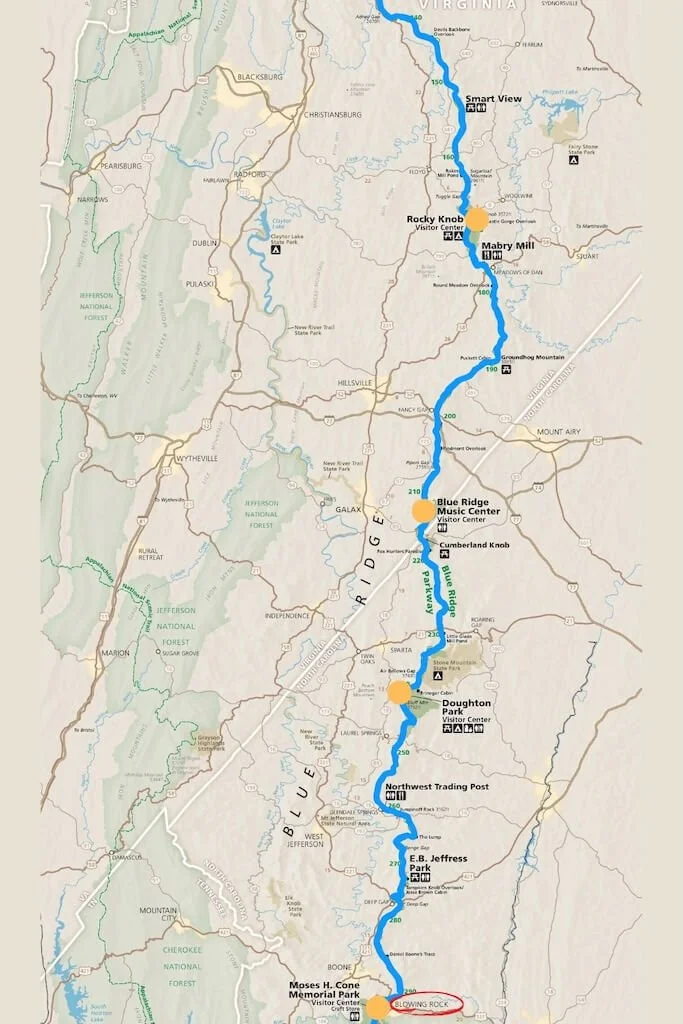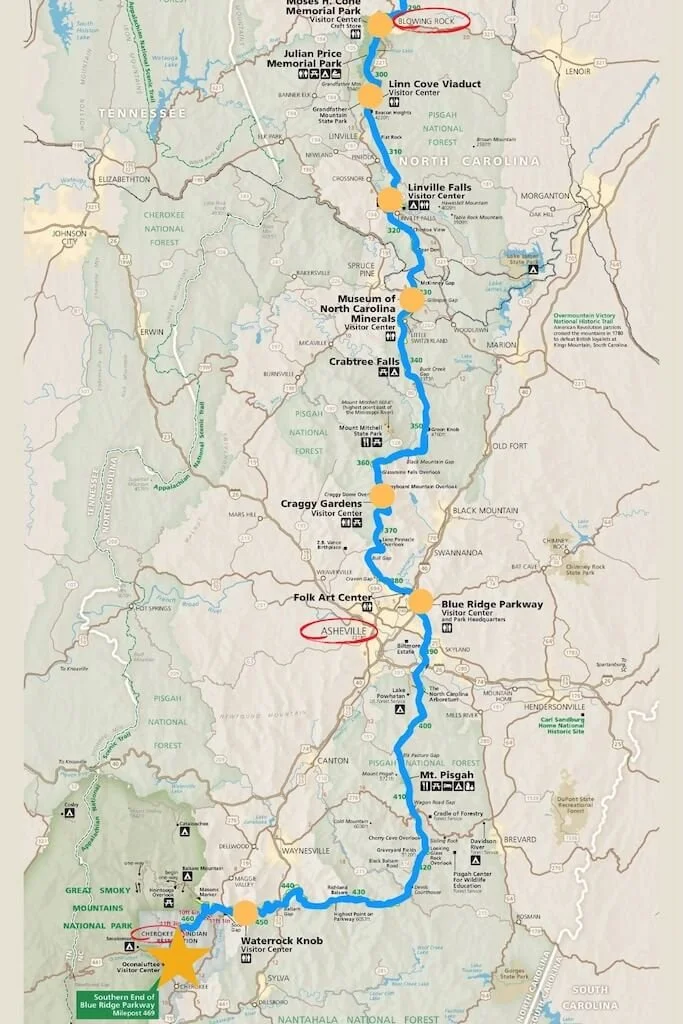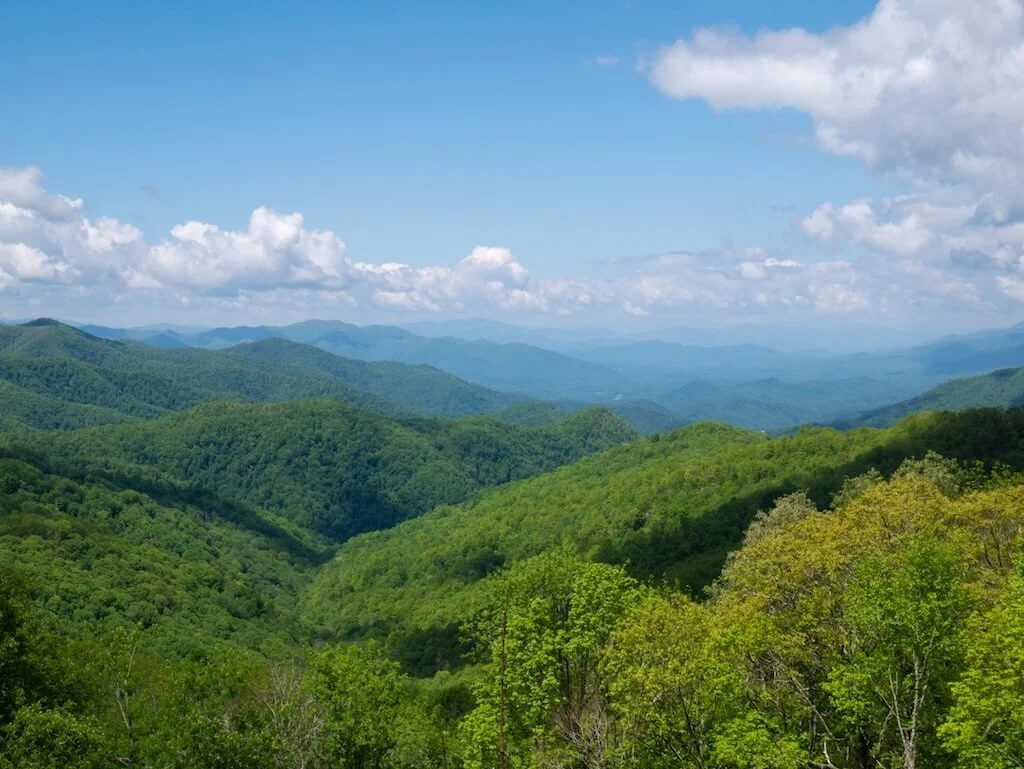Driving the Blue Ridge Parkway: A Beginner’s Road Trip Guide
The Blue Ridge Parkway is one of the most scenic drives in the United States! If you’ve ever wanted to take a slow, beautiful road trip through the mountains, this is it. Whether you're chasing fall foliage, hiking short trails, or winding through mountain towns, this beginner-friendly guide will help you get started.
Table of Contents Show
What is the Blue Ridge Parkway?
Stretching 469 miles through the Appalachian Mountains, the Blue Ridge Parkway connects two beautiful national parks: Shenandoah National Park in Virginia and Great Smoky Mountains National Park in North Carolina. Built as a slow, scenic alternative to the highway, the road follows the crest of the Blue Ridge Mountains, passing overlooks, historic sites, and small towns along the way.
It’s not about getting anywhere fast. The whole idea is to slow down and enjoy the drive!
The Best Time of Year to Drive the Blue Ridge Parkway
The Blue Ridge Parkway is open year-round, though conditions vary:
Spring (April-early June): Wildflowers, waterfalls, baby animals.
Summer (June-August): Cooler mountain temps, lush greenery, festivals.
Fall (late September-early November): Peak foliage season, with brilliant reds, oranges, and golds.
Winter (late November-March): Some sections close due to snow and ice. Always check the NPS road closure map before heading out.
🍂 Fall Tip: Color change happens first at high elevations and moves lower by late October into November.
High elevations on the Parkway include places like Craggy Gardens, Mount Mitchell, and Waterrock Knob, where leaves typically peak in late September to early October.
Mid-elevation areas such as Blowing Rock, Linville Falls, and Rough Ridge usually change color by mid to late October.
Lower elevations near Asheville and Cherokee peak later, often in late October into early November.
How many days does it take to drive the Blue Ridge Parkway?
If you drive straight through without stopping, you could drive the Blue Ridge Parkway in about 10-12 hours. But that misses the main goal of the Parkway! The road was designed for slow travel, with a 45 mph maximum speed limit (and often slower in curvy sections), frequent pull-offs, and endless short hikes, waterfalls, and small towns worth exploring.
For most travelers, 4-7 days is the sweet spot for driving the entire length. That gives you time to enjoy both national parks at either end, take a few hikes along the way, and spend evenings in mountain towns like Roanoke, Blowing Rock, Boone, or Asheville.
Here are some helpful benchmarks:
1 Day: Choose one section and focus on highlights. Asheville to Cherokee (87 miles) makes a great day trip, with stops at Looking Glass Overlook, Graveyard Fields Overlook, and Waterrock Knob.
3 Days: Drive half the Parkway. Shenandoah to Blowing Rock or Blowing Rock to the Smokies are both manageable three-day trips.
5 Days: A comfortable pace to drive the whole Parkway, with overnights in Roanoke, Blowing Rock, and Asheville.
7 Days: The ideal week-long trip. You’ll have time for both parks at the ends, plus side trips to towns, cideries, and longer hikes.
The best way to plan is to decide how many days you realistically have and then pick a section that matches. The Parkway rewards unhurried travel, so even if you only have one or two days, it’s better to enjoy a smaller stretch fully than to rush the entire drive.
Blue Ridge Parkway Map
The southern end of Shenandoah National Park marks the start of the Blue Ridge Parkway, near Waynesboro, Virginia. You’ll see the route highlighted in blue below, with yellow dots marking main areas and visitor centers. Popular overnight destinations are circled in red. The Blue Ridge Parkway ends near the Oconaluftee Visitor Center in Great Smoky Mountains National Park.
Best Stops Along the Blue Ridge Parkway
Here are some of the best stops from north to south:
Humpback Rocks (milepost 6.0): Kick off your trip with a steep, rewarding hike to a panoramic viewpoint and a visit to a historic mountain farmstead.
Mabry Mill (milepost 176): One of the most photographed spots on the Parkway.
Blue Ridge Music Center (milepost 213): Catch live performances, visit the museum, and take a short hike through the surrounding woods.
Blowing Rock & Moses H. Cone Memorial Park (near milepost 294): A charming mountain town with shopping, dining, and access to easy carriage trails, lakes, and views.
Linville Falls (milepost 316): A classic Blue Ridge waterfall. Multiple trail options.
Mount Mitchell (near milepost 355): The highest peak east of the Mississippi. You can drive to the top, then take a paved path to the summit observation deck.
Craggy Gardens (milepost 364): Short, scenic hikes with sweeping views. Especially magical in June when the rhododendrons are blooming.
Asheville, NC (near milepost 382): A vibrant city known for its art scene, great food, craft beer, and the Biltmore Estate. It's also a perfect home base for exploring nearby hikes.
Graveyard Fields Overlook (milepost 418.8): One of the Parkway’s most famous hiking areas, especially in the fall when the foliage peaks.
Devil’s Courthouse (near milepost 422.4): Known for its steep but short hike with four-state views, this is a top stop near Asheville.
Waterrock Knob (milepost 451.2): Popular for sunset, sweeping views, and the short but challenging hike to the summit.
Great Smoky Mountains National Park (milepost 469): The southern end of the Parkway connects directly into Great Smoky Mountains National Park. From the Oconaluftee Visitor Center, spot elk, hike into the mountains, or start your journey on Newfound Gap Road.
National Parks Near the Blue Ridge Parkway
The Blue Ridge Parkway connects two national parks: Shenandoah in the north and the Great Smoky Mountains in the south. If you have extra time, plan to extend your trip into one or both of these parks.
1 Day in Shenandoah National Park
At the northern end of the Parkway, Skyline Drive runs the length of Shenandoah National Park. This 105-mile road is a natural continuation of the Parkway experience, with the same slow pace and mountain views.
Top ways to enjoy Shenandoah:
Drive Skyline Drive and stop at overlooks like Stony Man or Rocky Top.
Stretch your legs on trails such as Dark Hollow Falls or Stony Man Summit.
For a longer adventure, hike Old Rag Mountain or sections of the Appalachian Trail.
Visit Big Meadows Lodge or Skyland Resort for classic park lodging.
Shenandoah is especially beautiful in spring with blooming wildflowers, and in fall when its forests burst into color earlier than the Parkway’s lower sections.
1 Day in Great Smoky Mountains National Park
At the southern end, the Blue Ridge Parkway flows directly into Great Smoky Mountains National Park near Cherokee, North Carolina. Stop first at the Oconaluftee Visitor Center, where you can often see elk grazing in the meadows, then spend a day exploring deeper into the Smokies.
Here’s one way to plan your time in the park:
Begin your morning with a hike. Choose Laurel Falls for a family-friendly walk, Rainbow Falls or Alum Cave for a moderate challenge, or Charlies Bunion or Mount LeConte for a full-day mountain climb.
In the afternoon, drive the 11-mile Cades Cove Loop to see wildlife and historic cabins, then enjoy a picnic in one of the meadows.
If you’re traveling in late May or early June, check out the synchronous firefly display, where thousands of fireflies light up the forest in perfect rhythm. A lottery system makes tickets essential, but if you miss it, consider stargazing instead. Clingmans Dome, the highest point in the park, is one of the best places in the Smokies for night skies.
Other highlights in the Great Smoky Mountains include Roaring Fork Motor Nature Trail, a winding one-way road past waterfalls and historic cabins, and Newfound Gap Road, which connects Cherokee to Gatlinburg with sweeping mountain views. Clingmans Dome Road branches off here for the short hike to the 360-degree summit tower.
If you want to expand your road trip even further, you can loop toward Bryson City and then tackle the Tail of the Dragon, a famously twisty stretch of highway with 318 curves in just 11 miles. From there, continue into Gatlinburg for a walk across the SkyBridge, or stick closer to nature with the dog-friendly Gatlinburg Trail or Oconaluftee River Trail.
Fall Foliage Along the Blue Ridge Parkway
Fall is the most popular time to drive the Blue Ridge Parkway. The mountains explode in color from late September through early November, with deep reds, golden yellows, and bright oranges painting the landscape.
Timing tips:
Higher elevations (like Mount Mitchell or Craggy Gardens) usually peak in late September to early October.
Mid-elevation areas (like Blowing Rock or Linville Falls) often peak in mid to late October.
Lower elevations and valleys (like Asheville or Cherokee) typically change late October into early November.
🍂 Use local foliage reports to time your visit and consider weekday travel to avoid crowds. Go early in the day for fewer people and softer light.
Blue Ridge Parkway: Driving Itineraries
Whether you have a single day or a full week, here are beginner-friendly road trip ideas:
1-Day Itinerary
For a 1-day Blue Ridge Parkway itinerary, choose one section and focus on highlights. Asheville to Cherokee (milepost 382-469) makes a great day trip.
Stop at the Folk Art Center for regional crafts.
Stop at Bad Fork Valley Overlook and Mills River Valley Overlook.
Hike the Fryingpan Mountain Lookout Tower.
Stop at more overlooks, such as the Cradle of Forestry, Looking Glass Rock, Graveyard Fields, Devil’s Courthouse, and Cowee Mountain.
Hike to the summit of Waterrock Knob for 360-degree views.
Stop at a few final overlooks on your way to Cherokee, including Thunderstruck Ridge, Plott Balsam, Lickstone, and Bunches Bald.
End at the Oconaluftee Visitor Center in the Great Smoky Mountains.
4-Day Itinerary
Day 1: Shenandoah NP to Roanoke (about 3 hours without stops)
Start at Afton Overlook, the start of the Blue Ridge Parkway near Waynesboro, Virginia.
Hike Humpback Rocks.
Stop at overlooks, such as Apple Orchard Mountain, Porter Mountain, and the Great Mountain.
Overnight in Roanoke.
Day 2: Roanoke to Blowing Rock
Start at the Blue Ridge Parkway, Roanoke.
Stop at overlooks, such as Cahas Mountain, Devils Backbone, Pine Spur, The Saddle, and Rock Castle Overlook.
Explore Mabry Mill and the Blue Ridge Music Center.
More stops at overlooks, including Grandview, Raven Rock, and Thunder Hill.
Explore Moses Cone Memorial Park
Overnight in Blowing Rock.
Day 3: Blowing Rock to Asheville
Hike Blowing Rock or Rough Ridge Lookout Trail.
Cross Linn Cove Viaduct, the most famous bridge on the Blue Ridge Parkway. (For photos of the viaduct, you can stop and hike the Linn Cove Viaduct via Tanawha Trail.)
Stop at overlooks, such as Grandfather Mountain, Bear Den, Deerlick Gap, Black Mountains, and Laurel Knob Overlook.
Detour up Mount Mitchell, the highest peak east of the Mississippi. (You can drive to the top, then take a paved path to the summit observation deck.)
Consider bonus hikes at Flat Rock Loop Trail, Linville Falls, Crabtree Falls, and Craggy Pinnacle Trail (shorter trail with spectacular views).
Overnight in Asheville.
Day 4: Asheville to Cherokee, NC
Stop at the Folk Art Center for regional crafts.
Stop at Bad Fork Valley Overlook and Mills River Valley Overlook.
Hike the Fryingpan Mountain Lookout Tower.
Stop at more overlooks, such as the Cradle of Forestry, Looking Glass Rock, Graveyard Fields, Devil’s Courthouse, and Cowee Mountain.
Hike to the summit of Waterrock Knob for 360-degree views.
Stop at a few final overlooks on your way to Cherokee, including Thunderstruck Ridge, Plott Balsam, Lickstone, and Bunches Bald.
End at the Oconaluftee Visitor Center.
One-Week Itinerary
Day 1: Shenandoah National Park
Start your adventure in Shenandoah with a full day on Skyline Drive.
Stop at overlooks like Stony Man and Big Meadows, and take a short hike to Dark Hollow Falls or Stony Man Summit.
For something more challenging, try Old Rag Mountain.
Have lunch at Big Meadows Lodge and end your day with sunset at one of the overlooks before overnighting near Waynesboro, VA.
Day 2: Shenandoah NP to Roanoke, VA (about 3 hours without stops)
Begin at Afton Overlook, the official start of the Parkway.
Hike Humpback Rocks for a classic summit view, then make time for overlooks such as Apple Orchard Mountain, Porter Mountain, and Great Mountain.
End your day with dinner and an overnight stay in Roanoke.
Day 3: Roanoke to Blowing Rock, NC
Follow the Parkway south, stopping at Cahas Mountain, Devils Backbone, Pine Spur, The Saddle, and Rock Castle.
Visit Mabry Mill and the Blue Ridge Music Center before continuing through overlooks like Grandview, Raven Rock, and Thunder Hill.
Wander the carriage trails at Moses Cone Park and finish in Blowing Rock for the night.
Day 4: Blowing Rock to Asheville, NC
Start with a morning hike on Rough Ridge Lookout Trail, one of the most iconic hikes on the Parkway. It’s a short but rewarding trek with views of the Linn Cove Viaduct and sweeping ridgelines.
Continue south across the Linn Cove Viaduct itself and enjoy overlooks like Grandfather Mountain, Bear Den, Deerlick Gap, Black Mountains, and Laurel Knob.
Stop in Little Switzerland for coffee or lunch with a view. (Consider the Chalet Restaurant or Terrace Dining at the Switzerland Inn for beautiful views.)
Detour up Mount Mitchell, the highest peak east of the Mississippi. You can drive to the top, then take a paved path to the summit observation deck.
Afternoon hike options include Flat Rock Loop, Linville Falls, Crabtree Falls, or Craggy Pinnacle.
Arrive in Asheville by late afternoon and celebrate with a cidery and brewery crawl. Urban Orchard Cider Co., Hi-Wire Brewing, and Wicked Weed are all local favorites. Overnight in Asheville.
Day 5: Asheville to Cherokee, NC
Spend the morning at Biltmore Estate, exploring downtown Asheville, or visiting the Folk Art Center and stops like Bad Fork Valley and Mills River Valley Overlooks.
Take a detour to Fryingpan Mountain Lookout Tower for sweeping views, then continue to Cradle of Forestry, Looking Glass Rock, Graveyard Fields, Devil’s Courthouse, and Cowee Mountain.
Cap the day with a short but steep hike to Waterrock Knob for 360-degree views.
End at the Oconaluftee Visitor Center in Cherokee and overnight nearby.
Day 6: Great Smoky Mountains National Park
Dedicate this day to the Smokies! Start with a hike: Laurel Falls for something easy, Alum Cave for a moderate challenge, or Charlies Bunion for a bigger adventure.
In the afternoon, drive the 11-mile Cades Cove Loop for wildlife viewing and historic cabins.
Toward evening, head to Clingmans Dome via Newfound Gap Road for sunset or stargazing.
Overnight in Cherokee or Gatlinburg.
Day 7: Smoky Mountains or Return Route
If you’re looping back north, use this day for a leisurely drive back through Asheville or a side trip to Bryson City and the Nantahala Gorge. If your trip ends here, enjoy a final morning in the Smokies before heading home.
Affiliate Disclosure: Some of the links in this section are affiliate links, which means we may earn a small commission if you make a purchase through them—at no extra cost to you. We only share places and products we truly love.
FAQ: Driving the Blue Ridge Parkway
Is the whole road paved and open to all vehicles?
Yes, the Blue Ridge Parkway is fully paved and open to cars, motorcycles, and RVs.
Is it free to drive?
Yes, there is no entrance fee to drive the Blue Ridge Parkway.
What are some drive times along the Blue Ridge Parkway?
Here are general drive times for popular sections:
Shenandoah National Park to Roanoke, VA: ~3 to 3.5 hours
Roanoke to Blowing Rock, NC: ~5 to 5.5 hours total
Blowing Rock to Asheville, NC: ~3 hours
Asheville to Great Smoky Mountains National Park (Cherokee): ~3 hours
Use the official Blue Ridge Parkway map from the National Park Service when planning your route.
What are the safety tips I should know?
The speed limit is 45 mph maximum, often lower. Expect to drive slower and allow extra time.
There are no gas stations directly on the Parkway. Exit into nearby towns to fuel up.
Cell service is spotty, so download offline maps before your trip.
Weather can change quickly at elevation. Bring layers, even in summer.
Fall weekends are busy. Visit midweek for lighter traffic and fewer crowds.
Is the Blue Ridge Parkway dog-friendly?
Yes, dogs are welcome at overlooks, picnic areas, and campgrounds, and many of the short trails along the Parkway allow pets. Some popular dog-friendly hikes include Humpback Rocks Loop, Sharp Top Trail, Boone Fork Trail, Rough Ridge Overlook Trail, Crabtree Falls, and Waterrock Knob.
Here are 7 dog-friendly things to do in the Great Smoky Mountains.
Where’s the best place to stay when driving the Blue Ridge Parkway?
If you’d rather stay directly on or just steps off the Parkway, there are a few iconic lodges and inns that make the experience even more special:
Peaks of Otter Lodge: A historic lodge sitting right on Abbott Lake, surrounded by mountains. It’s a peaceful base with hiking right outside your door.
Switzerland Inn: Guests love the Chalet Restaurant for its mountain-view dining.
Pisgah Inn: Perched high on the ridgeline, this is one of the most famous Parkway stays. The on-site restaurant has sweeping views, and the location is unbeatable for sunrise and sunset. Rooms book out months in advance, especially in the fall.
For those who prefer a mix of city convenience and Parkway access, you’ll also find plenty of hotels in nearby towns:
Roanoke, VA: Hotel Roanoke, Curio Collection (historic, downtown stay)
Boone/Blowing Rock, NC: Courtyard Boone or Fairfield Inn & Suites Boone (close to Parkway trails and Linville Falls)
Asheville, NC: Grand Bohemian Lodge, Biltmore Estates, Aloft Asheville Downtown (we love staying at Aloft when traveling with a dog)
Cherokee, NC: Fairfield Inn & Suites Cherokee (right at the Smokies’ doorstep), Watershed Cabins in nearby Bryson City (we stayed here for two months during our 2020 Travels, and it was an absolute mountain cabin dream!)
What are the best hikes along the Parkway?
Some of the best hikes along the Blue Ridge Parkway include the Rough Ridge Overlook Trail, Graveyard Fields Loop, Crabtree Falls Loop, Humpback Rocks, Craggy Gardens / Craggy Pinnacle, and Waterrock Knob.
Are there cideries or breweries nearby?
Yes, some great local stops are only a short drive from the Parkway!
Bold Rock Hard Cider (Nellysford, VA): Less than 10 minutes from MP 13.
Devils Backbone Basecamp Brewpub (Roseland, VA): About 10 minutes from the Three Ridges Overlook. (Devils Backbone Outpost Tap Room & Kitchen is about 20 minutes from the Blue Ridge Parkway Buena Vista Access Point.)
Urban Orchard Cider Co. (Asheville, NC): 10 minutes from MP 383.
Boojum Brewing Company (Waynesville, NC): About 10 minutes from the Blue Ridge Parkway - Great Smoky Mountains Expressway Access Point.
Where are the best places to eat along the Blue Ridge Parkway?
You’ll find a handful of restaurants on the Blue Ridge Parkway, plus some excellent options just a few minutes off the road. Here are some of the best places to eat, listed in order as you drive south from Shenandoah to Cherokee:
Chateau Morrisette: Fine dining paired with a winery setting.
The Bluffs Restaurant: A historic Blue Ridge Parkway dining spot.
Gamekeeper Restaurant: Upscale farm-to-table with local ingredients, located about 10 minutes off the Blue Ridge Parkway.
Chalet Restaurant at Switzerland Inn: Panoramic mountain views through wall-to-wall windows.
Switzerland Cafe & General Store: Casual stop for BBQ and sandwiches.
Pisgah Inn Dining: One of the Parkway’s most iconic restaurants, offering breakfast, lunch, and dinner with mountaintop views. (Open Seasonally April 1st to October 31st.)
Can I camp along the Parkway?
Yes, the Blue Ridge Parkway has several developed and backcountry camping options operated by the National Park Service.
What is the weather like on the Blue Ridge Parkway?
Weather varies by season and elevation. Higher points like Mount Mitchell or Waterrock Knob can be 15-20 degrees cooler than the valleys. Summer is mild compared to surrounding areas, but storms can roll in quickly. Spring brings wildflowers and some unpredictable rain, while fall offers crisp air and brilliant foliage. In winter, some sections close due to snow and ice. Always check conditions before you go.
Is the Blue Ridge Parkway a good road trip for families?
Yes! Families will find plenty of overlooks, picnic areas, and short hikes. Stops like Mabry Mill, Linville Falls, and Craggy Gardens are especially family-friendly.
When do the leaves peak in fall?
It depends on elevation. High points like Mount Mitchell and Craggy Gardens peak in late September to early October. Mid-elevations like Blowing Rock and Linville Falls often peak mid to late October. Lower areas like Asheville and Cherokee usually peak in late October into early November.
Can I bike the Blue Ridge Parkway?
Yes, but it is best for experienced cyclists. There are no shoulders, and the climbs can be intense. Traffic is generally respectful but slow-moving, so plan for challenging conditions. Learn more about biking the Blue Ridge Parkway here.
How do I plan a Blue Ridge Parkway road trip?
Planning a Blue Ridge Parkway road trip starts with deciding how much time you have.
In a single day, you can drive a highlight stretch such as Asheville to Cherokee or Shenandoah to Roanoke. With two or three days, focus on half the route, either the northern section down to Blowing Rock or the southern section from Blowing Rock to the Smokies. A full 4-7 days lets you enjoy the entire 469 miles with time for hikes, mountain towns, and fall color stops.
Most travelers begin at Shenandoah National Park in the north or Great Smoky Mountains National Park in the south, with overnight stops in Roanoke, Blowing Rock, Boone, or Asheville.
Are there closures or repair work on the Blue Ridge Parkway I should know about?
Yes, the Parkway often has temporary closures for maintenance, weather damage, or large-scale repair projects. The National Park Service maintains a Road Status & Closures chart that shows which stretches are open, closed, or ungated (i.e., open unless emergencies).
Note: Hurricane Helene inflicted widespread damage in 2024, especially in North Carolina. The National Park Service estimates over 50 landslides across nearly 200 miles, and recovery work continues in many places. See up-to-date road status & closures here.
Related Posts













Nestled among rolling hills and misty mountain peaks, Great Smoky Mountains National Park (GSMNP) is the most visited national park in the United States. From scenic drives to relaxing forest hikes, we've curated a list of some of the best dog-friendly things to do in the Great Smoky Mountains. Grab your pup, and let’s go!